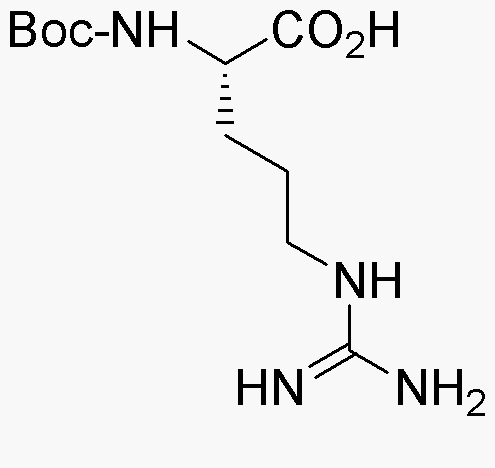Na-Boc-L-arginine is widely utilized in research focused on:
- Peptide Synthesis: This compound serves as a key building block in the synthesis of peptides, particularly in solid-phase peptide synthesis, allowing for the creation of complex biomolecules.
- Drug Development: It plays a role in the development of pharmaceuticals, especially those targeting cardiovascular diseases, due to its ability to enhance nitric oxide production.
- Bioconjugation: Researchers use it for bioconjugation processes, linking biomolecules to therapeutic agents, which is crucial in developing targeted drug delivery systems.
- Protein Engineering: The compound is essential in protein engineering applications, helping to modify proteins for improved stability and functionality in various industrial processes.
- Diagnostics: It is utilized in diagnostic assays, particularly in the detection of diseases, by serving as a substrate for enzymes that are indicative of specific health conditions.
General Information
Properties
Safety and Regulations
Applications
Na-Boc-L-arginine is widely utilized in research focused on:
- Peptide Synthesis: This compound serves as a key building block in the synthesis of peptides, particularly in solid-phase peptide synthesis, allowing for the creation of complex biomolecules.
- Drug Development: It plays a role in the development of pharmaceuticals, especially those targeting cardiovascular diseases, due to its ability to enhance nitric oxide production.
- Bioconjugation: Researchers use it for bioconjugation processes, linking biomolecules to therapeutic agents, which is crucial in developing targeted drug delivery systems.
- Protein Engineering: The compound is essential in protein engineering applications, helping to modify proteins for improved stability and functionality in various industrial processes.
- Diagnostics: It is utilized in diagnostic assays, particularly in the detection of diseases, by serving as a substrate for enzymes that are indicative of specific health conditions.
Documents
Safety Data Sheets (SDS)
The SDS provides comprehensive safety information on handling, storage, and disposal of the product.
Product Specification (PS)
The PS provides a comprehensive breakdown of the product’s properties, including chemical composition, physical state, purity, and storage requirements. It also details acceptable quality ranges and the product's intended applications.
Certificates of Analysis (COA)
Search for Certificates of Analysis (COA) by entering the products Lot Number. Lot and Batch Numbers can be found on a product’s label following the words ‘Lot’ or ‘Batch’.
Numéro de catalogue
Numéro de lot/série
Certificates Of Origin (COO)
This COO confirms the country where the product was manufactured, and also details the materials and components used in it and whether it is derived from natural, synthetic, or other specific sources. This certificate may be required for customs, trade, and regulatory compliance.
Numéro de catalogue
Numéro de lot/série
Safety Data Sheets (SDS)
The SDS provides comprehensive safety information on handling, storage, and disposal of the product.
DownloadProduct Specification (PS)
The PS provides a comprehensive breakdown of the product’s properties, including chemical composition, physical state, purity, and storage requirements. It also details acceptable quality ranges and the product's intended applications.
DownloadCertificates of Analysis (COA)
Search for Certificates of Analysis (COA) by entering the products Lot Number. Lot and Batch Numbers can be found on a product’s label following the words ‘Lot’ or ‘Batch’.
Numéro de catalogue
Numéro de lot/série
Certificates Of Origin (COO)
This COO confirms the country where the product was manufactured, and also details the materials and components used in it and whether it is derived from natural, synthetic, or other specific sources. This certificate may be required for customs, trade, and regulatory compliance.


